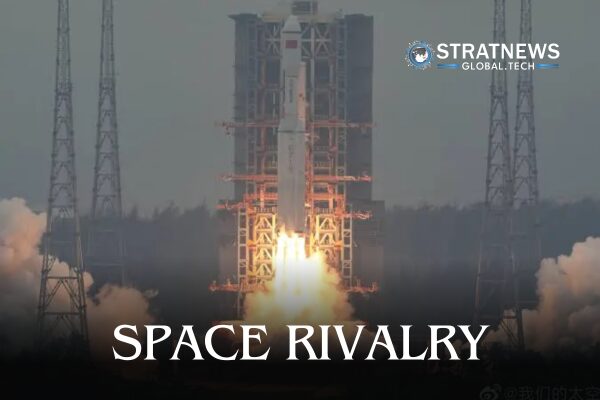China once again illustrated its growing confidence in space deployment with the successful launch of the Long March-8A rocket, a mission that not only expanded its satellite network but also reshaped the competitive dynamics of low-Earth orbit communications.
On August 25, 2025, at 19:08 UTC (03:08 local time), the third Long March-8A lifted off from the Wenchang Commercial Space Launch Site, deploying nine SatNet LEO Group 10 satellites into a 550-kilometer circular orbit. This launch forms part of the Guowang constellation program, managed by the China Satellite Network Group, which ultimately aims to place 13,000 satellites in orbit to provide global broadband connectivity. The mission marked the 192nd orbital launch attempt worldwide this year and the seventh successful mission for the Long March-8 family.
The Long March-8A represents a significant evolution in China’s rocket design. With a payload capacity of seven tonnes to a 700-kilometer sun-synchronous orbit, around 40 percent greater than the standard Long March-8, it demonstrates improved efficiency and reach. Its second stage integrates two upgraded YF-75H engines, each producing ten tonnes of thrust, while a wider 5.2-meter payload fairing allows for larger and multiple satellites.
Structural refinements have trimmed the rocket’s mass by 200 kilograms, increasing payload efficiency. The system is also capable of rapid turnaround, supporting a seven-day launch and reset cycle, a crucial feature for constellation-building efforts where speed and frequency are central.
These technical improvements, however, do not eliminate broader challenges. China’s ambitious satellite deployment schedules have revealed bottlenecks in manufacturing and logistics. The Qianfan constellation, which had planned 648 launches in 2025, may achieve fewer than 200 by year-end, with just 90 completed so far.
Despite these hurdles, the Guowang initiative underscores China’s strategic intent to expand its role in global communications, providing an additional system in a marketplace that is increasingly vital for both connectivity and national security.
The broader context highlights China’s steady growth in orbital activity. The country now operates more than 1,060 satellites—an increase of over 600 percent in a decade—with more than 510 of them serving intelligence, surveillance, and reconnaissance roles. In 2024 alone, China deployed 263 satellites into low-Earth orbit, contributing significantly to the record global cadence of one launch every 28 hours in the first half of 2025. This surge reflects both the scale of its national investment and its integration of satellite services into consumer products, as seen in partnerships with Huawei, Xiaomi, and BYD.
While China focuses on building vast operational constellations, India is advancing on a different trajectory, prioritizing human spaceflight through the Gaganyaan program. The first uncrewed mission, G1, is scheduled for December 2025 and will carry Vyommitra, a half-humanoid robot designed to monitor key spacecraft systems. This test flight aims to validate life support, avionics, and safety mechanisms ahead of future crewed missions. India has already completed over 80 percent of the 7,700 required tests for Gaganyaan, with the remaining assessments due by March 2026. A second uncrewed test will follow before the first crewed mission in early 2027, placing Indian astronauts in orbit aboard an indigenous spacecraft for the first time.
Recent milestones have bolstered India’s preparations. In 2025, the Indian Space Research Organisation (ISRO) successfully tested the parachute recovery system at the Satish Dhawan Space Centre, ensuring safe re-entry and landing procedures. Meanwhile, astronaut training has been strengthened by the participation of Group Captain Shubhanshu Shukla in the Axiom-4 mission, during which he spent 18 days aboard the International Space Station, gaining valuable experience for India’s future human spaceflight operations.
India’s program is also backed by expanded investment. The Gaganyaan mission budget has been raised to $2.32 billion, with plans for two crewed and six uncrewed flights by 2028, and a national space station targeted for 2035. These ambitions reflect a deliberate, long-term approach, emphasizing safety, reliability, and capability-building over rapid deployment.
When viewed together, the Long March-8A launch and the upcoming Gaganyaan mission illustrate two contrasting but complementary paths in the global space arena. China is accelerating near-Earth infrastructure development through high-frequency satellite deployments aimed at providing widespread connectivity and strengthening strategic autonomy. India, on the other hand, is investing in the human dimension of space exploration, methodically laying the groundwork for long-term presence in orbit and beyond. Both approaches contribute uniquely to the rapidly evolving space economy, projected to surpass $1 trillion by 2032.
Rather than competing on identical goals, these parallel missions highlight the diversity of strategies shaping space exploration today. China’s emphasis on satellite constellations reflects immediate applications in communications and technology integration, while India’s focus on human spaceflight underlines its commitment to exploration, science, and global collaboration. Together, they demonstrate how multiple pathways are redefining global space activity, underscoring the emergence of a multipolar era where innovation, cooperation, and competition will collectively shape humanity’s future in space.


